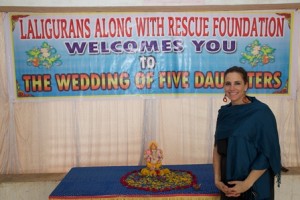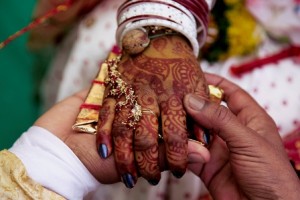Five Weddings And A Future
Our Made By Survivors team was just starting our visits to our local partners and production centers in Mumbai and Kolkata, and our first stop was the Rescue Foundation, Boisar, two hours from Mumbai, to participate in the joyous occasion of five survivors’ weddings.
The youngest girls were on the roof, waving to us as we approached the main hall. Down below, hundreds of others in jewel-tone saris danced, hennaed fingers birding the air, bare feet flickering the dusty walkway. The band, a team of hip Mumbai boys, drummed even the most reluctant in the crowd to life. Inside the hall, five thrones were set up on a stage for five grooms, with five thrones positioned facing them to seat their brides. The priest was already praying into his mic, and people were milling about the hall, sometimes climbing the stage to sit beside one or another couple to offer a blessing during the three hour ceremony.
I met an old man who told me he had driven 20 hours from the furthest corner of the state of Gujurat to be at the wedding (we were in the village of Boisar, at the border of Gujarat and Maharashtra, home of the great city Mumbai). He had brought his wife, who insisted on coming although she was very ill. This was an important day in their lives: the man was a sponsor for the wedding, and he had taken one of the girls as his “daughter” for the day. He and his wife sat beside her for hours, sprinkling yellow and white carnations around her and her betrothed, touching drops of milk to their lips, washing their feet. He was as proud as a father could be.
None of the brides at the wedding had parents present. All were surrounded by sponsors who had come to witness their joy, to stand in for missing families. Even aside from the number of marriages being performed simultaneously, this was an unusual wedding, for these girls were survivors of brothel slavery who had successfully been matched to husbands and were starting a new life.
The night before we had danced under the stars for hours with the girls—the brides and their “sisters” at the Rescue Foundation shelter home for displaced and abused girls, the vast majority of whom had been trafficked from Nepal, Bangladesh, and the Bengal region of India into Mumbai brothels. I had not even climbed out of the car to join the pre-wedding party when a group of girls took my hands and pulled me to the dancing area on the lawn. Pausing to yank my sandals off and toss them in a pile of shoes, they began spinning me around, pushing each other away in order to have a dance with this stranger in their midst. I haven’t danced so long and so hard in years—my team and I were uniformly exhausted at the end of the night, as much from smiling so hard and hugging so many girls so tightly as from imitating the range of dance moves. We speculated that perhaps the intensity of each girl as she sought to have a dance just alone with each of us translated their desire for attention, for love, for recognition and consideration that is such a basic human need, and that is so wholly unfulfilled in the world of brothel slavery.
Most of the 200+ girls at the Rescue Foundation are between 12 and 25 years old, and it was a joyous occasion for them to see five of their sisters setting out to start a new life as married women. The five grooms (and the grooms’ families) are progressive indeed. They must be so to transcend the stigma associated with trafficked women; the rejection, blame, and shame that often follow girls as they try to reintegrate into their homes and families after being rescued from the brothels. These men know all about the past suffering and trauma experienced by their wives-to-be, and they embrace them in the spirit of a new life, a better life. It is more fairy-tale than a fairy-tale, in some ways, and it is only because of the work of abolitionist heroes such as Mahesh and Treveni, leaders of the Rescue Foundation, that such stories come true. I should know: I just had the great good fortune to watch five survivors as they drove off into their new lives, leaving their unthinkable pasts behind.
Still, there are over 200 girls and women left in the Boisar shelter home. This is a tiny fraction of the rescued girls waiting to reintegrate into life after slavery, which is a still tinier fraction of the number of girls in Mumbai, in India, all over the world waiting to be rescued from life as brothel slaves. The youngest girls were on the roof, waving to us. They are 11 years old. Recently rescued. What will their futures be?
Elizabeth Swanson Goldberg
Associate Professor of English


